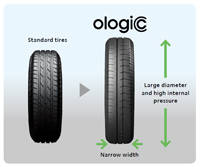While doing tire research I came across this following page, and hadn't seen it shared before:
https://www.bridgestone.com/responsi...ncy/index.html
Quote:
Contributing to Improved Fuel Economy with “Ologic,” an Entirely New Tire Concept
When a vehicle is in motion, a variety of resistance factors are working against it, including air resistance and tire rolling resistance, all of which reduce driving performance. Minimizing these resistances enable the vehicle to use less energy, which leads to improved fuel performance. The Bridgestone Group’s low fuel consumption tire technology “ologic” realizes superior performance through the following two features:
(1) These tires have a large diameter and high internal pressure (high inflated air pressure), which significantly reduce tire deformation from contact with the road surface and lower rolling resistance.
(2) The tire’s narrow tread design lowers air resistance, an important factor linked to improved vehicle fuel efficiency.

Furthermore, by optimizing the material, structure and pattern of the rubber and reinforcement layers, the rolling resistance coefficient is reduced approximately 30% compared to conventional standard tires. At the same time, safety performance in terms of vehicle handling on wet road surfaces is increased by approximately 10%.*1
“ECOPIA with ologic” tires employing “ologic” technology are standard equipment on the i3 revolutionary electric vehicle developed by BMW. They are also used on solar cars participating in the World Solar Challenge, the world’s top solar car race.
The Bridgestone Group aims to reduce CO2 emissions through improvements of vehicle fuel efficiency by promoting the reduction of CO2 emissions within manufacturing processes, as well as the technological development and global sales of more fuel efficient tires.
Comparison of tires employing “ologic” technology (Size: 155/70R19; Inflated air pressure: 320 kPa) and conventional tires (Size: 175/65R15; Inflated air pressure: 210 kPa) having the same load capabilities.
|
I know there's been some discussion about tire geometry - wider tires potentially having lower rolling resistance - but Bridgestone is apparently going the narrow route.
In other news, I just learned the VW XL1 uses tires which are almost identical in diameter to the G1 Insight's.